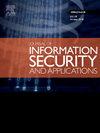A novel scheme to encrypting autonomous driving scene point clouds based on optical chaos
IF 3.7
2区 计算机科学
Q2 COMPUTER SCIENCE, INFORMATION SYSTEMS
Journal of Information Security and Applications
Pub Date : 2025-07-21
DOI:10.1016/j.jisa.2025.104166
引用次数: 0
Abstract
The widespread adoption of 3D point cloud technology in autonomous driving has raised concerns about the potential leakage of private information among Internet of Vehicles (IoV) users, especially when data is exchanged between vehicles without adequate protection. This paper introduces a novel encryption and decryption scheme for 3D point cloud data, designed to address security and privacy concerns in autonomous driving environments. The optical system, based on vertical-cavity surface-emitting lasers (VCSELs), is configured to generate optical chaos, which is then applied to the permutation and diffusion of 3D point clouds. In the case study, 3D point cloud images from the KITTI dataset are encrypted and decrypted, and the three classes of objects — cars, cyclists, and pedestrians — are detected in the original, encrypted, and decrypted datasets using the Point-Voxel Region Convolutional Neural Network (PV-RCNN). The mean average precision (mAP) for the encrypted dataset is nearly zero, indicating that the 3D point cloud objects cannot be detected. In contrast, the mAP for the decrypted dataset closely matches that of the original dataset, demonstrating the effectiveness and feasibility of the proposed privacy protection scheme. Additionally, a detailed security analysis of the geometric features in 3D point clouds confirms that the scheme provides robust security and privacy protection for the scene information in 3D point cloud images.
基于光学混沌的自动驾驶场景点云加密新方案
3D点云技术在自动驾驶领域的广泛应用引发了人们对车联网(IoV)用户隐私信息泄露的担忧,尤其是当数据在没有充分保护的情况下在车辆之间交换时。本文介绍了一种新的3D点云数据加密和解密方案,旨在解决自动驾驶环境中的安全和隐私问题。基于垂直腔面发射激光器(VCSELs)的光学系统被配置为产生光学混沌,然后将其应用于3D点云的排列和扩散。在案例研究中,对KITTI数据集中的3D点云图像进行加密和解密,并使用点体素区域卷积神经网络(PV-RCNN)在原始、加密和解密的数据集中检测汽车、骑自行车的人和行人这三类对象。加密数据集的平均精度(mAP)接近于零,表明无法检测到三维点云对象。与此相反,解密数据集的mAP与原始数据集的mAP非常接近,证明了所提出的隐私保护方案的有效性和可行性。此外,对三维点云的几何特征进行了详细的安全性分析,证实了该方案为三维点云图像中的场景信息提供了强大的安全性和隐私保护。
本文章由计算机程序翻译,如有差异,请以英文原文为准。
求助全文
约1分钟内获得全文
求助全文
来源期刊

Journal of Information Security and Applications
Computer Science-Computer Networks and Communications
CiteScore
10.90
自引率
5.40%
发文量
206
审稿时长
56 days
期刊介绍:
Journal of Information Security and Applications (JISA) focuses on the original research and practice-driven applications with relevance to information security and applications. JISA provides a common linkage between a vibrant scientific and research community and industry professionals by offering a clear view on modern problems and challenges in information security, as well as identifying promising scientific and "best-practice" solutions. JISA issues offer a balance between original research work and innovative industrial approaches by internationally renowned information security experts and researchers.
 求助内容:
求助内容: 应助结果提醒方式:
应助结果提醒方式:


